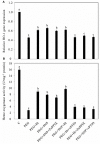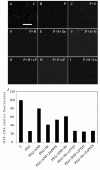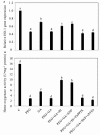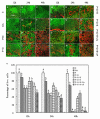Heme Oxygenase-1 Delays Gibberellin-Induced Programmed Cell Death of Rice Aleurone Layers Subjected to Drought Stress by Interacting with Nitric Oxide
- PMID: 26834769
- PMCID: PMC4717306
- DOI: 10.3389/fpls.2015.01267
Heme Oxygenase-1 Delays Gibberellin-Induced Programmed Cell Death of Rice Aleurone Layers Subjected to Drought Stress by Interacting with Nitric Oxide
Abstract
Cereal aleurone layers undergo a gibberellin (GA)-regulated process of programmed cell death (PCD) following germination. Heme oxygenase-1 (HO-1) is known as a rate-liming enzyme in the degradation of heme to biliverdin IXα, carbon monoxide (CO), and free iron ions (Fe(2+)). It is a critical component in plant development and adaptation to environment stresses. Our previous studies confirmed that HO-1 inducer hematin (Ht) promotes the germination of rice seeds in drought (20% polyethylene glycol-6000, PEG) conditions, but the corresponding effects of HO-1 on the alleviation of germination-triggered PCD in GA-treated rice aleurone layers remain unknown. The present study has determined that GA co-treated with PEG results in lower HO-1 transcript levels and HO activity, which in turn results in the development of vacuoles in aleurone cells, followed by PCD. The pharmacology approach illustrated that up- or down-regulated HO-1 gene expression and HO activity delayed or accelerated GA-induced PCD. Furthermore, the application of the HO-1 inducer Ht and nitric oxide (NO) donor sodium nitroprusside (SNP) not only activated HO-1 gene expression, HO activity, and endogenous NO content, but also blocked GA-induced rapid vacuolation and accelerated aleurone layers PCD under drought stress. However, both HO-1 inhibitor zinc protoporphyrin IX (ZnPPIX) and NO scavenger 2-(4-carboxyphenyl0-4, 4,5,5-tetramethylimidazoline-l-oxyl-3-oxide potassium salt (cPTIO) reserved the effects of Ht and SNP on rice aleurone layer PCD under drought stress by down-regulating endogenous HO-1 and NO, respectively. The inducible effects of Ht and SNP on HO-1 gene expression, HO activity, and NO content were blocked by cPTIO. Together, these results clearly suggest that HO-1 is involved in the alleviation of GA-induced PCD of drought-triggered rice aleurone layers by associating with NO.
Keywords: Oryza sativa; aleurone layers; drought stress; gibberellin; heme oxygenase-1; nitric oxide; programmed cell death.
Figures







Similar articles
-
Hydrogen sulfide delays GA-triggered programmed cell death in wheat aleurone layers by the modulation of glutathione homeostasis and heme oxygenase-1 expression.J Plant Physiol. 2014 Jan 15;171(2):53-62. doi: 10.1016/j.jplph.2013.09.018. Epub 2013 Nov 16. J Plant Physiol. 2014. PMID: 24331419
-
Exogenous Hydrogen Peroxide Contributes to Heme Oxygenase-1 Delaying Programmed Cell Death in Isolated Aleurone Layers of Rice Subjected to Drought Stress in a cGMP-Dependent Manner.Front Plant Sci. 2018 Feb 1;9:84. doi: 10.3389/fpls.2018.00084. eCollection 2018. Front Plant Sci. 2018. PMID: 29449858 Free PMC article.
-
Heme oxygenase-1 is involved in nitric oxide- and cGMP-induced α-Amy2/54 gene expression in GA-treated wheat aleurone layers.Plant Mol Biol. 2013 Jan;81(1-2):27-40. doi: 10.1007/s11103-012-9979-x. Epub 2012 Oct 23. Plant Mol Biol. 2013. PMID: 23090695
-
Programmed cell death in cereal aleurone.Plant Mol Biol. 2000 Oct;44(3):255-66. doi: 10.1023/a:1026584207243. Plant Mol Biol. 2000. PMID: 11199387 Review.
-
Programmed cell death (PCD): an essential process of cereal seed development and germination.Front Plant Sci. 2014 Jul 28;5:366. doi: 10.3389/fpls.2014.00366. eCollection 2014. Front Plant Sci. 2014. PMID: 25120551 Free PMC article. Review.
Cited by
-
OsVPE3 Mediates GA-induced Programmed Cell Death in Rice Aleurone Layers via Interacting with Actin Microfilaments.Rice (N Y). 2020 Mar 30;13(1):22. doi: 10.1186/s12284-020-00376-6. Rice (N Y). 2020. PMID: 32232682 Free PMC article.
-
Advances in Understanding Drought Stress Responses in Rice: Molecular Mechanisms of ABA Signaling and Breeding Prospects.Genes (Basel). 2024 Nov 27;15(12):1529. doi: 10.3390/genes15121529. Genes (Basel). 2024. PMID: 39766796 Free PMC article. Review.
-
Overexpression of TaSNAC4-3D in Common Wheat (Triticum aestivum L.) Negatively Regulates Drought Tolerance.Front Plant Sci. 2022 Jul 4;13:945272. doi: 10.3389/fpls.2022.945272. eCollection 2022. Front Plant Sci. 2022. PMID: 35860542 Free PMC article.
-
Interaction between endogenous H2O2 and OsVPE3 in the GA-induced PCD of rice aleurone layers.Plant Cell Rep. 2021 Apr;40(4):691-705. doi: 10.1007/s00299-021-02665-w. Epub 2021 Feb 9. Plant Cell Rep. 2021. PMID: 33559721
-
Research Progress on the Functions of Gasotransmitters in Plant Responses to Abiotic Stresses.Plants (Basel). 2019 Dec 13;8(12):605. doi: 10.3390/plants8120605. Plants (Basel). 2019. PMID: 31847297 Free PMC article. Review.
References
-
- Bai X. G., Chen J. H., Kong X. X., Todd C. D., Yang Y. P., Hu X. Y., et al. (2012). Carbon monoxide enhances the chilling tolerance of recalcitrant Baccaured ramiflora seeds via nitric oxide-mediated glutathione homeostasis. Free Radical. Biol. Med. 53 710–720. 10.1016/j.freeradbiomed.2012.05.042 - DOI - PubMed
LinkOut - more resources
Full Text Sources
Other Literature Sources

